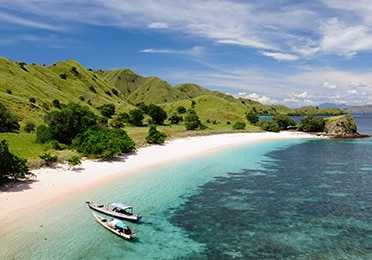The Bali Starling (Leucopsar rothschild) also known as the Rothschild’s Mynah or Bali Mynah, and locally called Jalak Bali is a critically endangered species, endemic to the island of Bali. Today in the wild these very rare birds can be found only in the West Bali National Park and at Nusa Penida.
Arguably the most beautiful of all Mynahs, the Bali Starling is easily recognized by its pure-white coat, fringed with black along the tips of the tail and wings and with striking blue skin around the eyes. A beautiful white crest extends from the top of his head as a final touch on this exquisite little bird. There is no significant difference between the male and female of the species.
The Bali Starling is a songbird measuring approximately 25 centimeters. They breed in the rainy season between the months of November and May. Their bluish-green eggs are oval shaped, with an average diameter of about three centimeters.
The Bali Starling was discovered on March 24, 1911 by a British ornithologist named Dr. Stressmann Baron. Dr Baron was travelling on the expedition ship, the Maluku II, which had to make a sudden stop on the island of Bali due to damage to the vessel. Stressmann first spotted the Starling in Bubunan Village, about 50 kilometers from Singaraja, Northern Bali. He categorized it as a new species, rare and different from any other whole specimen.
The bird’s Latin name, Leucopsar rothschild, was given by a British animal expert named Walter Rothschild who first published the description of the bird to the world in 1912.
In 1925, further studies by Dr. Baron Viktor Von Plesen showed that the Starling was only found in the area between the Brumbun Gulf and the Kelor gulf in western Bali, making those approximately 320 square kilometers the only natural habitat of the Bali Starling on the planet. During this time, the number of starlings in the wild were estimated at between 300-900 birds.
Soon after its discovery, the Bali Starling became the object of hunting, poaching and illegal trade. Aside from its eye-catching appearance, the bird’s melodic voice made it increasingly coveted by collectors and bird lovers alike. Furthermore, its status as a rare and endemic creature in addition to its exotic beauty and singing voice placed its value at hundreds of millions of rupiah. The rapid deforestation of the bird’s limited habitat was the final straw that drove the Starling to the brink of extinction.
With just 6 Bali Starlings left in the wild, the much sought after bird was thrust into the critical status of the endangered species. Captive bred starlings were then released into the wild, bringing their numbers up to 24. Although 400 more were released into the wild throughout the 1990's, by 2005, authorities showed the numbers to have once again dropped to less than 10. In present day, while the exact number of the species in the wild is unknown, estimates in 2012 showed at least 24 adult birds in the West Bali National Park, and over 100 on the neighboring Balinese island of Nusa Penida. About 1,000 more are believed to be held in captivity legally in zoos and parks around the world, and perhaps more than twice as many are still being sold and traded in the black market.
In 1937, the Balinese tiger (Pantheratigrisbalica) was declared officially extinct due to hunting, and habitat loss. But perhaps if we can protect our environment and the abundance of life it supports, we can prevent other animals from befalling the same fate.
















